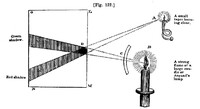7. L, M, N, o, [in fig. 122], is a piece of white paper, illumined as in the figure; D is a small cylinder of wood, as a black lead pencil, or even one's finger, in such a manner, as to produce the respective shadows D, v, and D, K; c, being a piece of red glass in this experiment. 8. If, instead of red glass, a piece of green glass be placed at c, then the shadow D, v, will no longer be green, but of a reddish cast; and so of the rest as mentioned above, at Sect. 3. 9. My friend was very desirous that I should endeavour to account for these beautiful and most extraordinary appearances; with this view, I first observe, that the burning lights, A and B, when the experiments are made without daylight, may be reckoned nearly white, particularly if they are made to burn without smoke, though, in reality, they are yellowish, or even orange-coloured sometimes, as is very plain when they are compared with strong daylight. 10. Secondly, white light is well known to consist of several other colours, as red, orange, yellow, green, blue, purple, and violet; and, further, as violets and purples, with all their varieties, may be imitated by mixing blue and red in different proportions; and, as green also may be compounded in a similar way by mixing blue and yellow; and oranges by mixing red and yellow; we need not attend to more than the three primary colours, red, yellow, and blue; for, in fact, it is found that by mixing these three colours in certain proportions, a sort of white, or any colour may be formed; and there is reason to believe that, if we had colours equal in brilliancy to the prismatic colours, the white so formed would be perfect.

